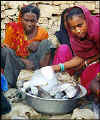| the-south-asian.com SEPTEMBER 2001 | ||
| about us contact us data bank past issues the craft shop the print gallery | ||
|
SEPTEMBER 2001 Contents Interview Heritage Cultural Heritage of south Asia People Communities Lifestyle Films Editor's Note
Books
Enduring Spirit
|
Page 1 of 3
by Zachariah Cherian
Mampilly
The term Indo-Africans refers to Indians of African origin and was coined by Professor Abdulaziz Lodhi of Uppsala University, Sweden. I am grateful to him for his help in writing in this article.Little is known about Africans who moved from the African continent to the Indian subcontinent, some as slaves, but others purposefully and freely. A study of this Indo-African population offers a realistic portrayal of Africans as traders, warriors, and sailors.According to Dr. Richard Pankhurst, commercial contacts between Ethiopia and India are mentioned in the Periplus – a Graeco-Egyptian commercial manual written around the first century AD. This manual mentions that the Aksumite port of Adulis, on the Red Sea coast of Africa, "traded extensively with various parts of Western India, which supplied Ethiopia with both textiles and spices." Later texts mention trade with Ceylon as well. Habshis were present in Colombo, in Ceylon, where Ibn Battuta reports that Jalasti, "the wazir and ruler of the sea", had "about five hundred Abyssinians". More than 250,000 descendants of Africans still live amongst the Indian people. They are a vast and diverse population spread throughout India with separate histories and unique roles within the Indian strata. Although Africans have been crossing the Indian Ocean into India for over a millennium, most of those who make up the Indo-African population came in the past five hundred years. Most were mercenaries or prisoners of war of the Muslim rulers. Africans also came as midwives and herbalists, and as musicians, sailors and merchants. In the second decade of the sixteenth century a European traveller named Armando Cortesao noted that: "The people who govern the kingdom [Bengal] are Abyssinians [Ethiopians]. These men are looked upon as knights; they are greatly esteemed; they wait on the kings in their apartments."
Copyright © 2000 - 2001 [the-south-asian.com]. Intellectual Property. All rights reserved. |
|


